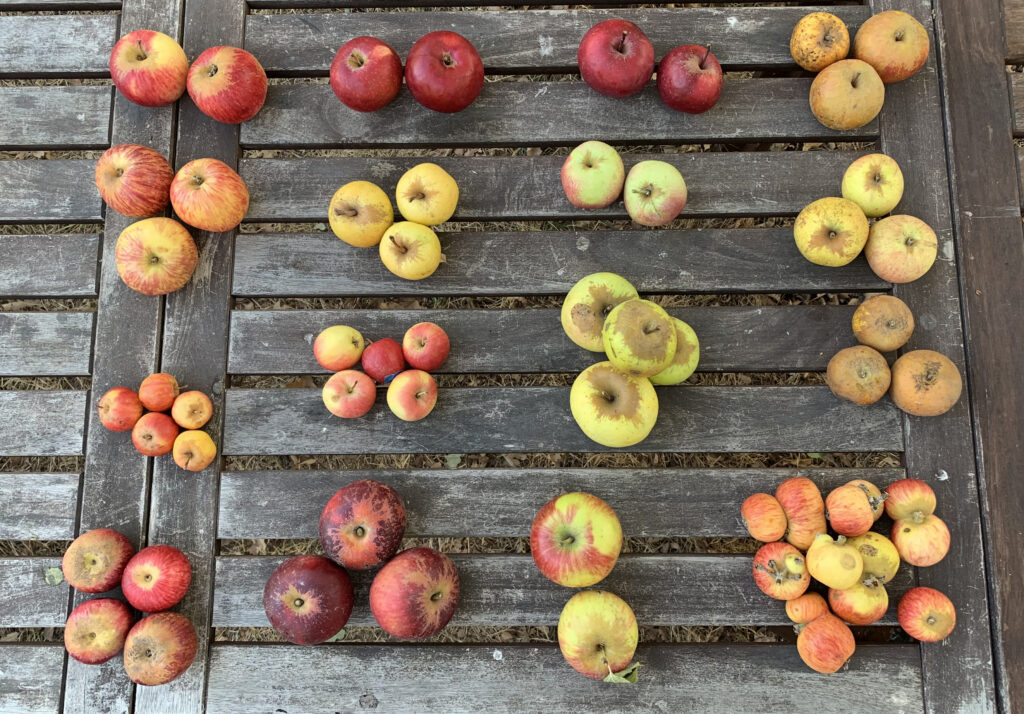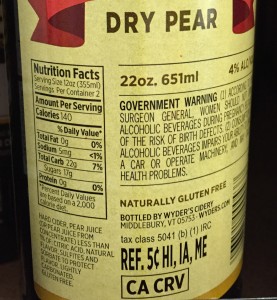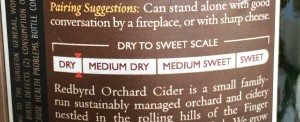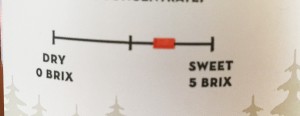This essay originally appeared in Issue 7 (2019) of the zine Malus. In the coming months I’ll explore this broader notion of cider apples by taking a closer look at individual varieties–their history, what happens when someone ferments them, common and distinctive aromas and flavors that reflect place and process. Pour yourself a glass and join me!
It is time that we expanded our notion of just what is and isn’t a cider apple.
Spend enough time with serious cider enthusiasts and eventually talk will turn to “proper cider apples” and how they are the sin qua non of cidermaking. It is clear to the speaker that “good” cider can only be made with real cider apples, by which is generally meant apples with a lot of tannin in them, “spitters”, otherwise unfit for anything else. There may well be a little bemoaning of the fact that these sorts of bittersweet and bittersharp apples are not widely available in the United States, and wouldn’t American ciders be so much better if they were. There will be slightly worshipful talk around the celebrated names of Kingston Black, Porter’s Perfection, Yarlington Mill, and Dabinett, fine apples all.
There are problems with this sort of thinking. The first is, of course, the many long-standing cider traditions that don’t focus on a high-tannin flavor profile or require a significant proportion of tannin-containing apples in the mix. Germany, especially in the area around Frankfurt am Main, has one such tradition, but one far older is that of northern Spain. Modern Spanish cidermakers do identify many particular varieties as being best for cider, but they are predominantly high acid, low tannin apples, sharps, not bittersweets or bittersharps which typically make up only about five percent of a blend.
A far more troublesome issue, perhaps, is more a narrowness of mind, a shrinking of possibility. It’s akin to the mindset that has driven the market for table apples into a corner where a tiny handful of varieties dominate. It’s also the equivalent of saying that the only “good” wine is red. And what’s more, a small subset of reds, excluding an easy drinking, fruity Beaujolais, for example, and focusing only on Bordeaux blends that aren’t actually drinkable until they’ve had a good ten plus years of aging to soften their tannins so they don’t feel like they are stripping the enamel off the drinker’s teeth.
LESSONS FROM THE PAST
Many of history’s favorite apples for cidermaking were not bittersweets or bittersharps at all. Some of the most highly prized cider apples of 17th century England, such as the Genet Moyle and the Golden Pippin, were, in fact, also celebrated as dessert and/or cooking apples. “Our Gennet Moyles are commonly found in hedges, or in our worst soil . . . But this fruit makes the best Cyder in my Judgement, and such as I do prefer before the much com- mended Redstreak’d,” wrote John Beale in a letter to polymath Samuel Hartlib, subsequently published as Herefordshire Orchards, a Pattern for All England in 1656. He goes on to say, “[I’]tis (at a distance) the most fragrant of all Cyder Fruit, and gives the liquor a most delicate perfume. So for Tarts and Pyes it is much commended.” Beale’s contemporary, agriculturist John Worlidge, echoed this sentiment in his Vinetum Britannicum, or a Treatise of Cider (1676). “The Gennet Moyle is a pleasant and necessary Fruit in the Kitchin, and one of the best Cider-Apples. The Fruit is well marked, and the Trees great bearers.” Of the Golden Pippin Worlidge says, “[T]he Golden Pippin will very well deserve a place in your plantation, being a very great bearer, and the fruit one of the best for the Table as well as the Mill.”

The Golden Pippin kept its reputation intact well into the late 1800s, but by the 18th century there was a new favorite dual-purpose apple on the table, the Stire (aka Styre or Forest Styre). “Of Apples, the Stire stands first in estimation,” wrote William Marshall in The Management of Orchards and Fruit Liquor in Herefordshire, Volume II (1796). “It is deemed, by most people, a tolerably good eating apple. The cider, which is produced from it . . . is rich, highly flavored, and of a good body, its price frequently fourfold that of common sale cider.” James Thatcher repeated this sentiment, writing, “This is the most celebrated and extensively cultivated cider apple in England, and is also a good eating apple” (The American Orchardist, 1822), as did pomologist Robert Hogg when he observed that “The cider that it produces is strong bodied, rich, and highly flavored” (British Pomology, 1851).
None of these apples are grown much today, but there are many other examples that will be familiar–the Gravenstein, for example. “This apple is equally useful for the table and other purposes of economy; as it not only affords excellent cider, but also when dry a very palatable dish; it may be kept fresh during the greater part of the winter,” wrote William Kendrick in The New American Orchardist in 1833. Of the Winesap, William Cox wrote, “This is one of our best cider fruits, and is much esteemed as a good eating apple,” and “. . . I have cider of 1810, the mixture of [Hewe’s] Crab and Harrison and Winesap . . . which annually improves like the finest wine” (A View of the Cultivation of Fruit Trees, 1817). Both Hewe’s Crab and Harrison, probably the most famous cider apples originating in the United States, it should be noted, would not be considered bittersweet/bittersharp apples by today’s standards.
FARMERS ARE NOT FOOLS
Historically, why would there have been so much interest in dual-purpose fruit? Farmers are practical people, and they always have been. For most of human history, anyone not living in a city–by far the majority–had to grow most of what they needed to survive and feed their families: grain, vegetables, fruit and animals. Some portion of what was produced went to pay rent on the land, since the elites of the world who rarely got their own hands dirty owned most of it, and if there was a little left over a farmer might be able to either sell it or trade it for those things that he (almost never she) couldn’t produce himself. Multi-purpose was the name of the game. Cows could be milked or butchered; sheep provided meat, milk and wool; chickens gave eggs and could end up in a pot once their useful laying days were over. Grain fed people, and made beer if you had enough of it, and the spent stalks fed livestock in winter.
Subsistence farming also dictated how someone used whatever land was available to him. Many acres had to be found for grazing and grain production. Fruit trees, if planted in an orchard, were spaced widely, 30-40 feet apart, to allow for other crops to be grown between them. They were also grown as large trees so that livestock could graze beneath, though dwarfing rootstocks had been known since the third century BCE and widely used for espaliered trees in the gardens of the wealthy by the 1500s. Apple trees were often planted on the margins or in hedgerows where they could serve as boundary markers and not interfere with the growing of other crops. In this world, before the advent of farming-for-the-market that really took off in the 19th century, a multi-purpose apple, one that could provide both good food and good drink, would have been a very attractive thing indeed.
A NEW WAY FORWARD
So, herein it is proposed that a new definition of “cider apples” be adopted. Let them be any apples selected and grown with cidermaking in mind. Let them be sweet and sharp, suffused with tannin and not. Recognize and embrace the magic and complexity that can be found in a cider made from Newtown Pippin, Northern Spy, or McIntosh, which when grown to be fermented and then processed by an attentive cidermaker can be transformed into something magical and complex, rich with both flavor and history. Eschew the path that wine took, now finding itself in a place where six or so grape varieties dominate the international market and regional varieties struggle to survive or drift into extinction. Celebrate nuance, not the narrowness of a focus on tannin. Lovers of “good” cider can do better.





